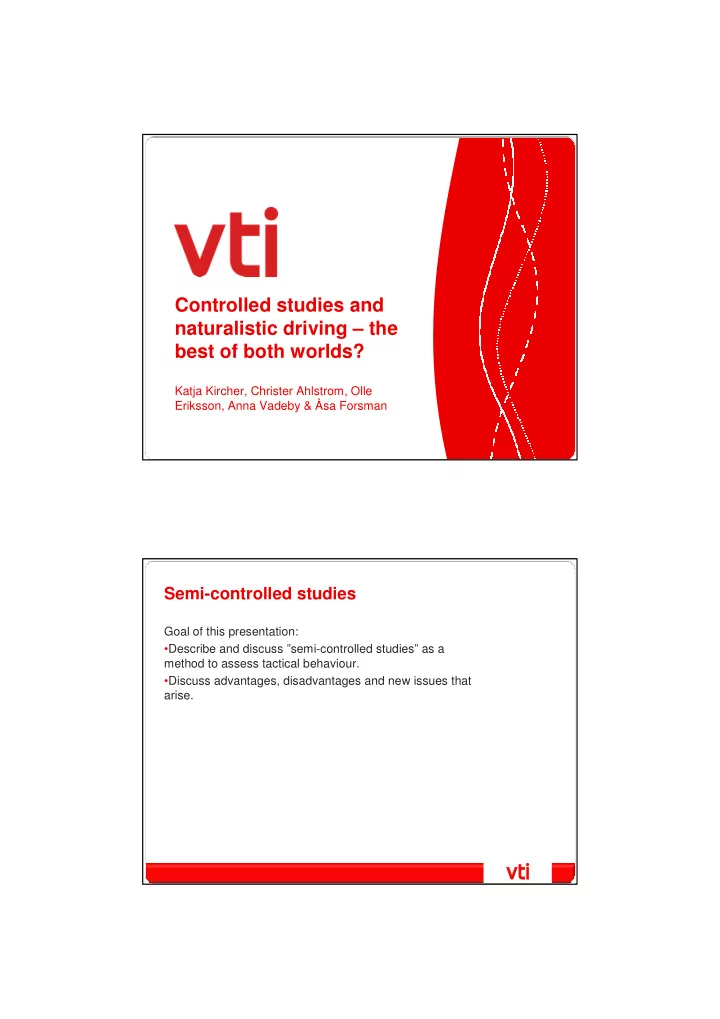

Controlled studies and naturalistic driving – the best of both worlds? Katja Kircher, Christer Ahlstrom, Olle Eriksson, Anna Vadeby & Åsa Forsman Semi-controlled studies Goal of this presentation: •Describe and discuss ”semi-controlled studies” as a method to assess tactical behaviour. •Discuss advantages, disadvantages and new issues that arise.
Experimental studies tell us: Executing ”secondary tasks” during driving changes driving behaviour from baseline driving and is therefore probably dangerous. Underlying assumption: •Baseline behaviour is best. Implication: •Performance indicators on the operational level are of most interest. Comment: •Experimental control allows for causal inferences. Naturalistic studies tell us: Executing ”secondary tasks” during driving is not necessarily associated with an increased risk. Implications: •Naturalistic driving is real life and therefore ”more true”. Extensive experimental control is often found in simulator studies. Simulators are not real and the results therefore less believable. Comments: •No causal inferences possible due to self- assignment. •”Corresponding baseline selection” doubtful due to self-assignment. •Even though tactical behaviour could be analysed, it rarely is.
Assumption – one is not better than the other! Both approaches tell us something: •Controlled studies show what would happen if an additional task was executed in a certain situation. •Naturalistic studies show whether drivers actually do execute such a task in that type of situation. Therefore the different study types can tell us different things. But can we keep control and still learn about naturalistic ways to deal with additional tasks? Is there a ”best of both worlds”? We intended to study behaviour on the operational and tactical level in a naturalistic-like setting with experimental-like control. We wanted to investigate whether possible deviations from ”baseline” were smart compensation strategies or loss of control and suboptimal performance.
Generic setup • Assign participants to conditions. • Decide on the tasks to be done. • Decide on route to be taken or possibly start and goal. • Stress that we are interested in the participants’ natural behaviour, not in some imagined competition for ”best behaviour”. � Within these frame conditions we let participants solve the task as they see fit. So far we conducted two studies with this setup. Field study – mobile IT and cycling How do bicyclists interact with mobile IT in real traffic? •22 young bicyclists on predetermined route •5 conditions (within subjects): baseline, music, phone, sms, www •comprehensive data collection
Simulator study – voice based hazard reports How do drivers use a voice based hazard report system? •17 young drivers on predetermined route in low-cost simulator •4 conditions (within subjects): baseline, ”free”, video, ”forced” •standard data collection General findings • Cyclists and simulator drivers seem to adapt their behaviour to demands and circumstances by planning ahead and using more or less conscious compensation strategies. • Road users are not ”helpless victims of additional tasks” but ”smart tacticians and satisficers” interested in survival. • Deviations from baseline often serve a purpose.
Method discussion – advantages • Setup successful to assess tactical behaviour – participants clearly made use of the option to use different strategies. • External assignment to conditions allows causal inferences. • Baseline selection easy to motivate. • Data collection relatively cheap and fast while still containing important naturalistic elements. � This method fills a gap by combining the best of two worlds. What are the drawbacks, then? The more freedom we give in experiments, the harder we have to think about the analysis. Two examples: •Possibly many subgroups with qualitatively different behaviour (cyclists stop or continue cycling while texting). • groups may become too small for inferential statistics • maybe not possible to use the same performance indicators in all subgroups •Task execution likely to occur in different locations (are those locations equivalent?). • we may lose some of the essential bits of experimental control
Subgroup issue In our field study only two obvious subgroups (stop vs not stop). Both were analysed separately: •Stops were counted per condition and participant. •When not stopped, several performance indicators were analysed. No qualitative subgroup division occurred in the simulator study. Baseline comparability issue In both cases a corresponding baseline section was extracted for each individual and each task. In our field study the route was rather homogeneous, so we assumed equivalence between baseline sections. This allowed us to evaluate treatment conditions not only against baseline but also against each other (via baseline). In the simulator study different sections of the route were decidedly inhomogeneous (just before a moose lounging around at the roadside vs. just behind this moose). We did not find a satisfactory solution and reverted to analysing the number of occurred verbal reports in different locations in the different conditions.
Invitation Let’s spend some time and effort on developing analysis techniques for this type of method. We consider it worthwhile as it will help us understand tactical behaviour better. This, in turn, may help us improve the traffic system such that we can consider the users’ needs and build on their own solutions to deal with complicated tasks. Thank you for your attention! Katja Kircher VTI S – 58195 Linköping Sweden
Recommend
More recommend